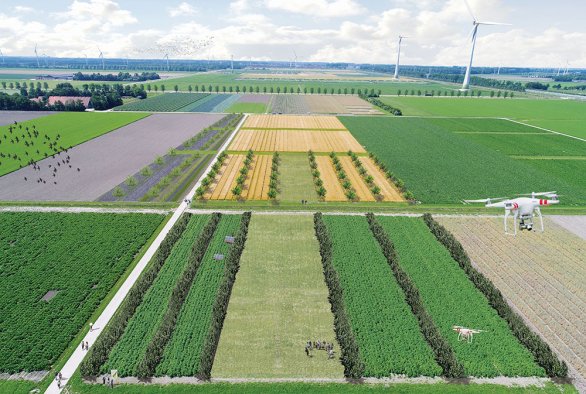Wageningen, The Netherlands
August 27, 2020

An undulating field of golden wheat, almost luminescent under the setting sun. Within hours, the same field has become a barren wasteland. All of the grain has been harvested, including the twenty per cent that was not yet ripe. With pixel agriculture, this will soon be a thing of the past.
To get an idea of pixel agriculture, imagine a gigantic chessboard with squares measuring fifty by fifty centimetres. On one square there is cabbage, on the next carrots, while other squares have wheat or onion growing on them. This setup allows you to harvest what is ripe and leave what is not. The total yield of the field is greater than with traditional monoculture, where the entire crop is harvested in a single go. This increase in yield could be as high as 25 per cent.
Harvesting robots
Much like a vegetable garden, where you only pick what is ripe. ‘We certainly do not want to go back in time’, says Dirk van Apeldoorn, Crop Diversity researcher at Wageningen University & Research. ‘The development of harvesting robots specifically designed for pixel agriculture ensures that the labour costs remain the same. The technology is not entirely ready, but we are already gathering data using a testing field, for when that time comes.’
Mixed agriculture
Pixel cultivation is a type of mixed agriculture—much the same as strip-tilling. Strip-tilling is already a viable alternative for farmers. This method of cultivation means growing different crops on the same field in strips of six to as much as twenty-four metres wide. Both these forms of mixed agriculture offer ecological benefits, in addition to higher yields. They cause an increase in the number of insects and show improved soil life in comparison to fields that are planted with a single crop. This leads to an increase in biodiversity. Moreover, if one strip or pixel is being harvested, the insects can seek shelter in the adjacent strip or plot.
Van Apeldoorn hopes that the introduction of mixed farming methods will place ecology at the centre of agriculture once again. ‘It could bridge the gap between nature and agriculture, which is exactly what we strive for’, he states.
Bij pixellandbouw zwaait de plant de scepter
Een golvend goudgeel veld tarwe, haast glimmend bij zonsondergang. Een paar uur later is op diezelfde akker niks meer over van de romantische aanblik. Alle tarwe is geoogst, ook de twintig procent die nog niet helemaal rijp was. Pixellandbouw moet dat in de toekomst voorkomen.
Stel je bij pixellandbouw een levensgroot schaakbord voor met vlakken van vijftig bij vijftig centimeter. Op het ene vlak staat kool, op het andere wortel en daarnaast weer tarwe en ui. Je kunt op deze manier per pixel oogsten wat rijp is en de rest langer laten staan. De totale opbrengst van een akker wordt hierdoor hoger dan in conventionele monocultuur, waarbij alles in één keer wordt geoogst. In het gunstigste geval zelfs vijfentwintig procent.
Oogstrobots
Vergelijk het met een moestuin, waarbij je alleen oogst wat rijp is. ‘Maar we willen zeker niet terug naar de tijd van Ot en Sien’, zegt Dirk van Apeldoorn, onderzoeker Gewasdiversiteit aan Wageningen University & Research. ‘Juist door de ontwikkeling van oogstrobots specifiek voor pixellandbouw hoeft het niet veel arbeidsintensiever te zijn. Die techniek is er nog niet helemaal maar we verzamelen met een proefakker alvast kennis voor als die er wel is.’
Mengteelt
Pixellandbouw behoort tot de categorie ‘mengteelt’. Ook strokenteelt is daar een vorm van, die al wel haalbaar is voor boeren. Daarbij staan verschillende gewassen naast elkaar in brede stroken van bijvoorbeeld zes of zelfs vierentwintig meter. Beide vormen van mengteelt bieden, naast een hogere opbrengst, ook ecologische voordelen. Ze trekken meer insecten aan en verhogen het bodemleven ten opzichte van een veld dat vol staat met één gewas. Daarmee vergroten ze de biodiversiteit op het land. En als één pixel of strook wordt geoogst dan kunnen de insecten nog vluchten naar het naastgelegen gewas.
Van Apeldoorn hoopt dat door invoering van mengteelt de ecologie weer leidend wordt voor agricultuur. ‘Het slaat een brug tussen natuur en landbouw en dat is waar we heen willen’, vindt hij.